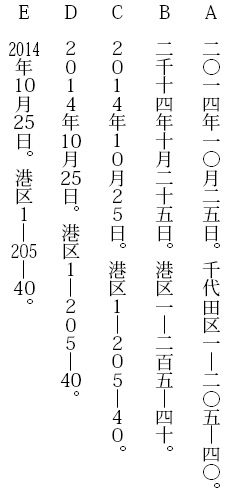This largely depends on whether you write horizontally (横書【よこが】き) or vertically (縦書【たてが】き).
In horizontal writing, Arabic numeral are preferred in almost all cases. 「2014年10月25日」 is the most common way.
Things are different and difficult in vertical writing. Kanji numbers (Kansuji; 漢数字【かんすうじ】) are much more preferred than in horizontal writing, but Arabic numbers are still frequently used.
See the picture below. All of these are frequently used for dates, but their usage differs.
A. One-by-one transliteration of Arabic numerals into kansuji. Note 「〇」 character which represents zero (漢数字ゼロ). This is very easy to write and read. This is the preferred way if you have to write numbers such as phone numbers and zip codes in kansuji .
B. Kansuji based on its pronunciation. This is very orthodox way, and works good for shorter numbers. "今日は十月二十五日だ" (written vertically) certainly looks better than "今日は一〇月二五日だ" or any other styles described here, if its written in the middle of ordinary sentences in novels, etc. However this can soon be long and difficult to understand for larger numbers. So avoid this style if you write dates repeatedly.
C. Put Arabic numbers vertically. This is simple and actually seen everywhere, but sometimes considered to be not good in professional books, novels, and magazines.
D. This style is called 縦中横【たてちゅうよこ】 (horizontal-in-vertical). Two (or sometimes three) numerals are combined and written as if they were one character. This rule is preferred to write numbers in modern newspapers and magazines. But good software support is required (and unfortunately MS Word handles this terribly).
E. Intensive use of 縦中横【たてちゅうよこ】 for numbers larger than 100. Sometimes I see this in mangas and casual magazines.


